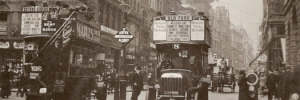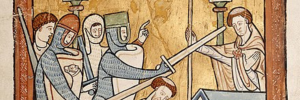William FitzOsbert is often mentioned as the first known criminal to be executed at Tyburn in 1196 for poll tax rioting.
Who was William FitzOsbert?
Often thought of as a Londoner and the son of ‘Osbert the Clerk’. His family wasn’t rich but he did manage to secure university education where he studies law. He was said to have been endowed with ‘a sharp mind’, was ‘moderately educated but unusually eloquent’. After university he joined the third crusade to the Holy Land in an attempt to expel Saladin’s Muslim Saracens and retake Jerusalem. He returning about 1192-3, when he became involved in the internal civic politics of London. The early 1190s was a time where taxation was provoking serious tensions between the rich and poor people of the city of London.
How do we know this? There are four contemporary chroniclers who wrote about FitzOsbert’s life and death: William de Newburgh, Roger of Hoveden, Gervase of Canterbury and Ralph de Diceto.
‘He (King Richard) used England as a bank on which to draw and overdraw in order to finance his ambitious exploits abroad.’ A. L. Poole
“Richard Coeur de Lion, occupied with the crusades, had no mind for the personal government of England. He depended on his ministers for money to pay for his military expeditions to Palestine. England was to him nothing more than a subject province to be bled by taxation.” Joseph Clayton
Collecting taxes and levies was ‘left to Londoners themselves’. The Great Chronicle details how the aldermen of each City ward met at the ‘wardmoot’, an institution that went back to Anglo-Saxon times. Consent then needed to be obtained and then each citizen was meant to contribute according to his wealth, although normally wealthier citizens were expected to pay at a higher rate than poorer people. If anyone possessed a ‘stone house’ they were deemed to be wealthy and ‘singled out and required to contribute at a higher rate’. Even though this sounds simple enough it was being increasingly bypassed and ignored by the wealthier citizens of London. Many were the descendants of the Norman conquerors; the poor being mostly the Saxon English.
London’s poorer citizens resented rich Londoners for not, as they saw it, paying their fair share, as much as they resented the exorbitant taxes themselves. William Fitz Osbert shared their resentment.
William Longbeard
He and his kinsmen had ‘adhered to this ancient English fashion of being bearded as a testimony of their hatred against their Norman masters’. (Matthew Paris) thus earning him the nickname ‘longbeard’.
He had become a champion of the poor of London through publicly speaking of the trials born by the poor. He travelled London with an entourage of followers. It’s recorded that he had amassed over 52,000 supporters, a huge number given the population of the City at that time. Weapons had been sought for the purpose of breaking into the houses of the rich citizens of London. This was a riot against the rich, not the king, Richard I.
“Great and frequent were the talliages imposed upon the City of London, for Richard’s ransom: and the burthen, according to the popular opinion, was increased, by the inequality of its apportionment or repartition. London at this period, contained two distinct orders of citizens: the Aldermen, the “Majores” or “Nobiles”, as they are termed in the ancient Year Books of the City, the Patricians or higher order, constituting (as they asserted) the municipal Communia, and constantly exercising the powers of government. To these, were opposed the lower order, who — perhaps being subdivided amongst themselves into two tribes of plebeians — maintained that they were the true Communia, to which, as of right, the municipal authority ought to belong. And in these conflicting ranks, an historical theorist may suppose that he discovers the vestiges of the remote period, when London was inhabited by distinct races or nations, each dwelling in their own peculiar town — the Ealdormannabyrigy still known as the Aldermanbury — inhabited by the nobles or conquering caste: whilst the rest of the city was peopled by the tributary or subject community. All contemporary chroniclers tell the same story: there was massive discontent because the wealthy and powerful were trying to avoid their share of the levy being raised to pay the king’s ransom. (Sir Francis Palgrave)
The Archbishop of Canterbury (Hubert Walter), saw the danger and sent men to arrest FitzOsbert when he was alone. There was an altercation. One of the Archbishop’s men was killed and FitzOsbert escaped with a few followers and took refuge in the nearby church of St Mary le Bow on Cheapside.
[1196] “In this yere was one William with the long berde taken out of Bowe churche and put to dethe for herysey.” Greyfool
Armed men under the instructions from the Archbishop burned down the church. FitzOsbert emerged from the smoke and flames and was stabbed in the stomach by the son of the man whom he had killed earlier. Urban riots were uncommon in 12th and 13th century England with one so the happenings in the spring of 1196 was an exception.
Justice was swift. Within days he was convicted and “first drawn asunder by horses, and then hanged on a gibbet with nine of his accomplices who refused to desert him”. I can’t find any mention of where the gibbets were displayed. Does anyone know?
His followers claimed him to be a martyr. The spot where he was hanged became a daily place of gathering; objects associated with his execution were venerated, and even the soil at the spot where he died was collected, resulting in the creation of a pit. Eventually armed guards were put in place to keep people away.
The story of FitzObert was retold by social reform writer Charles Dickens:
“There was fresh trouble at home about this time, arising out of the discontents of the poor people, who complained that they were far more heavily taxed than the rich, and who found a spirited champion in William Fitz-Osbert, called Longbeard. He became the leader of a secret society, comprising fifty thousand men; he was seized by surprise; he stabbed the citizen who first laid hands upon him; and retreated, bravely fighting, to a church, which he maintained four days, until he was dislodged by fire, and run through the body as he came out. He was not killed, though; for he was dragged, half dead, at the tail of a horse to Smithfield, and there hanged. Death was long a favourite remedy for silencing the people’s advocates; but as we go on with this history, I fancy we shall find them difficult to make an end of, for all that.” Dickens states Smithfield as the place of execution perhaps mixing up the two sites known at the elms (?).
References:
https://archive.org/details/chronicleofgreyf00londrich/page/n39/mode/2up?view=theater
Historia rerum anglicarum, Book 5 Ch.20-7
The Collected Historical Works of Sir Francis Palgrave, K.H.: Volume 9, Francis Pelgrave
A. L. Poole in the Oxford History of England
Charles Dickens. A Child’s History England. 1852.
Leaders of the People; Studies in Democracy, Joseph Clayton



